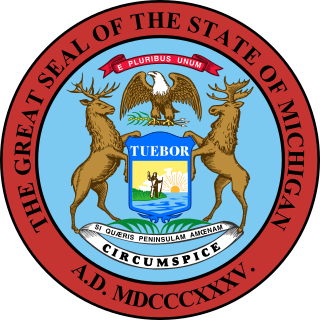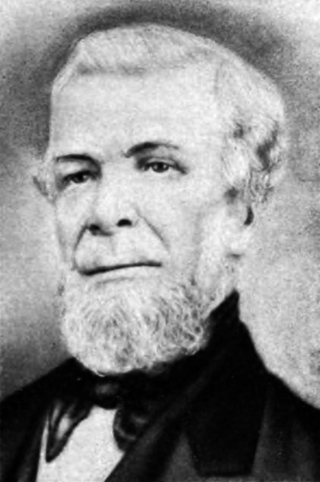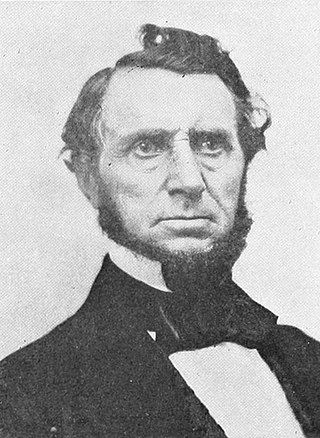The Toledo War (1835–36), also known as the Michigan–Ohio War or the Ohio–Michigan War, was a boundary dispute between the U.S. state of Ohio and the adjoining territory of Michigan over what is now known as the Toledo Strip. Control of the mouth of the Maumee River and the inland shipping opportunities it represented, and the good farmland to the west were seen by both parties as valuable economic assets.

The 1836 United States presidential election was the 13th quadrennial presidential election, held from Thursday, November 3 to Wednesday, December 7, 1836. In the third consecutive election victory for the Democratic Party, incumbent Vice President Martin Van Buren defeated four candidates fielded by the nascent Whig Party.

The Constitution of the State of Michigan is the governing document of the U.S. state of Michigan. It describes the structure and function of the state's government.

John J. Adam was a Scottish-American teacher, businessman, and politician. He served in a number of elected and appointed positions in the first years of Michigan's statehood, including state treasurer, auditor general, and regent of the University of Michigan, as well as multiple terms in the state house of representatives and state senate.
John McDonell, also spelled McDonnell, was a Scottish–American judge and politician active in the U.S. state of Michigan. During the War of 1812, he helped pay the ransom of a number of prisoners held by Native Americans following the River Raisin Massacre. He served in the Michigan Senate in the early years of its existence.
Jonathan D. Davis was an American physician and politician. He served in the Michigan Senate in the early years of Michigan's statehood.
Laurent Durocher was an American judge and politician in the U.S. state of Michigan. He was involved in the formation of Monroe County, Michigan, and held numerous official posts during the first decades of its existence, and was also a member of both the Michigan House of Representatives and Michigan Senate.
Orrin Howe was an American farmer and politician who was one of the first settlers in Lodi Township, Michigan, and served three terms in the Michigan House of Representatives.

Townsend E. Gidley was an American politician who served eight terms in the Michigan Legislature and was instrumental in the drafting of the state's first constitution.

Gardner Davenport Williams was an American politician who served two terms in the Michigan Senate and two terms in the Michigan House of Representatives.
Horace A. Noyes was an American lawyer and politician who served in the Michigan House of Representatives in its first session after adoption of the state constitution.
Jonathan Prescott Fay was an American physician and politician who served in the Michigan House of Representatives in its first session following adoption of the state's constitution in 1835, and died while in office.
George Howe was an American politician who served in the Michigan House of Representatives immediately after adoption of the state's first constitution.
Allen Hutchins was an American politician who served in the Michigan House of Representatives in its first session after adoption of the state constitution.
Darius Mead was an American politician who served one term in the Michigan House of Representatives.
Francis Charter was an American politician who served two terms in the Michigan House of Representatives.
Benjamin Sherman was an American politician who served one term in the Michigan House of Representatives in its first session after adoption of the state constitution.

The Sixth Michigan Territorial Council was a meeting of the legislative body governing Michigan Territory, known formally as the Legislative Council of the Territory of Michigan. The council met in Detroit in two regular sessions, one extra session, and one special session between January 7, 1834, and August 25, 1835, during the terms of George B. Porter and Stevens T. Mason as territorial governors.
The Michigan Territorial Council, known formally as the Legislative Council of the Territory of Michigan, was the legislative body of the Territory of Michigan from 1824 to 1835, when it was succeeded by the Michigan Legislature in anticipation of Michigan becoming a U.S. state. A session of the council including only members from what would become Wisconsin Territory met in 1836.






